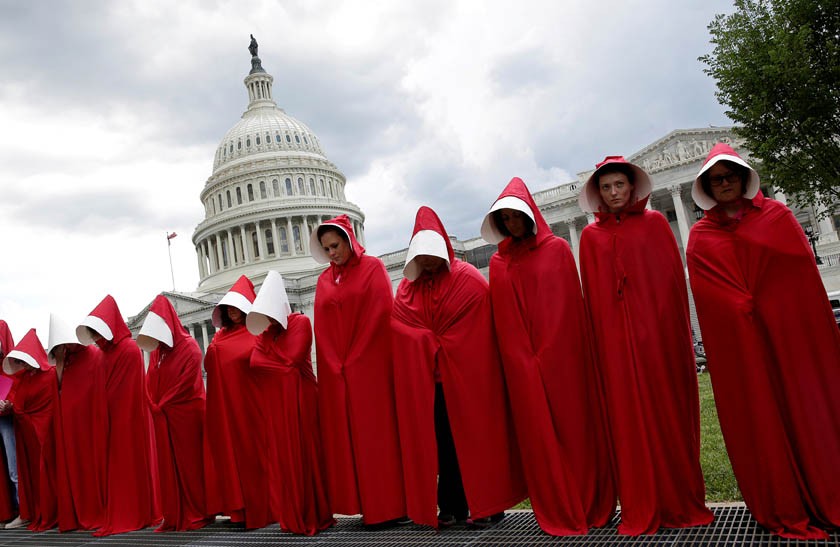
The story of Offred, published in 1985, may be cautionary for the West but depicts already existing conditions for women in Pakistan

For a book published in 1985, The Handmaid’s Tale has received a lot of recent attention due to what the Western press, at least, calls its "timeliness" and "prescience". Such are the woes of the Trump-era: A novel about a dystopian near-future where women are reduced to child-bearing vessels, not allowed to work, or even to refer to themselves by their own name, is starting to look frighteningly realistic.
But to a Pakistani reader, the themes in The Handmaid’s Tale are less cautionary than reminiscent of already existing conditions for women in our country. The beauty of a good dystopian novel is that it should never stray too far from that which could happen as well as that which is already happening. It then reveals that truth by weaving it into a worst-case scenario.
Such is the tale of Offred, a woman who is essentially a modern-day slave to a powerful state commander. The commander is unable to bear children with his wife, a woman with only marginally more power than Offred herself. Although the protagonist doesn’t describe it as an outright rape, she is subject to monthly intercourse with the commander, while his wife holds Offred down. The birth of a child, through this monthly ritual, will increase her chances of Offred’s survival in Atwood’s dystopian society.
Offred’s story, and the story of scores of other handmaids in the novel, is a story we hear often in Pakistan. She must always be accompanied by someone when leaving the house; her social value is inextricably linked to her ability to bear children, she is disallowed from reading, writing, employment and/or making financial decisions, and the idea of requiring her consent to have sex is non-existent.
Further, not only is this misogyny entrenched in the culture of Gilead (the empire that Offred’s commander is a powerful leader of, heavily implied to be the Unites States) but it’s also a fixed component of its legal framework. In short, her position as a second class citizen on the basis of gender is wholly institutionalised and systemic. Much like in the real world, the power of women in the novel is moderated by, and relative to, their race, class, marital status, age and ability to bear children, nevertheless, women as a group are the primary targets of Gilead’s totalitarian regime through state narratives, law, policing, and, unsurprisingly, religious justification.
What has made The Handmaid’s Tale witness a resurgence in pop culture and political discourse, however, is the perception of its relevance in countries that have long considered themselves ‘free’ compared to Pakistan or Saudi Arabia but are now faced with a rather less benign-appearing world leader than they would have imagined a year ago. The irony is obvious, especially after reading The New York Times review of the book from 1985 which dismisses the novel’s concerns as wholly unrealistic. A television show based on the story released this year has been both wildly popular and critically acclaimed, with pro-women’s rights protests in the US even being attended by women wearing ‘handmaid’ costumes as described in the novel. After all, the US is now officially presided over by a man who has been documented on video describing himself sexually harassing a woman, and is currently intent on reducing access to reproductive health care.
Much of this talk of ‘prescience’, however, has ignored one of the most fascinating aspects of the book, given it was written in a pre-9/11 world. The uprising that creates Gilead, a military dictatorship, is fuelled by racism and insecurity, with people allowing their rights to be taken away: "They blamed it on the Islamic fanatics … That was when they suspended the Constitution. They said it would be temporary," Atwood writes. Whether you think of increased militarism and surveillance in a world that continues to experience a ‘War on Terror’, or every military dictatorship Pakistan has witnessed, it’s an idea that is both prescient and familiar at once. The complete political and personal control that the commander and his ilk practice over their society emerges when the population decides to let them do so.
Atwood, of course, does not paint the story of Offred in such broad or overtly political strokes. What makes The Handmaid’s Tale a classic is not an inelegant narrative of black and white attempts at ‘female empowerment’, with a heroic protagonist. In fact, Offred, unlike her more broadly drawn television counterpart, finds herself in a world where she is closed in by systems of power so vast that to even think of escape is difficult (We know this because the entire book is internal to Offred’s thoughts, like a diary).
Thus, perhaps most bleakly, Offred is an anti-heroine who often makes choices that are practical rather than principled; cowardly rather than brave. Even then, her fate always remains precarious. It is a testament to Atwood’s literary skill that while the plot advances slowly in the first half of the book, the anticipation she creates that something could go horribly wrong for a woman trying to keep her head down in this society, fuels suspense about Offred’s fate. One doesn’t have to be invested in either American or Pakistani political culture to be consumed by how the novel progresses or ends.